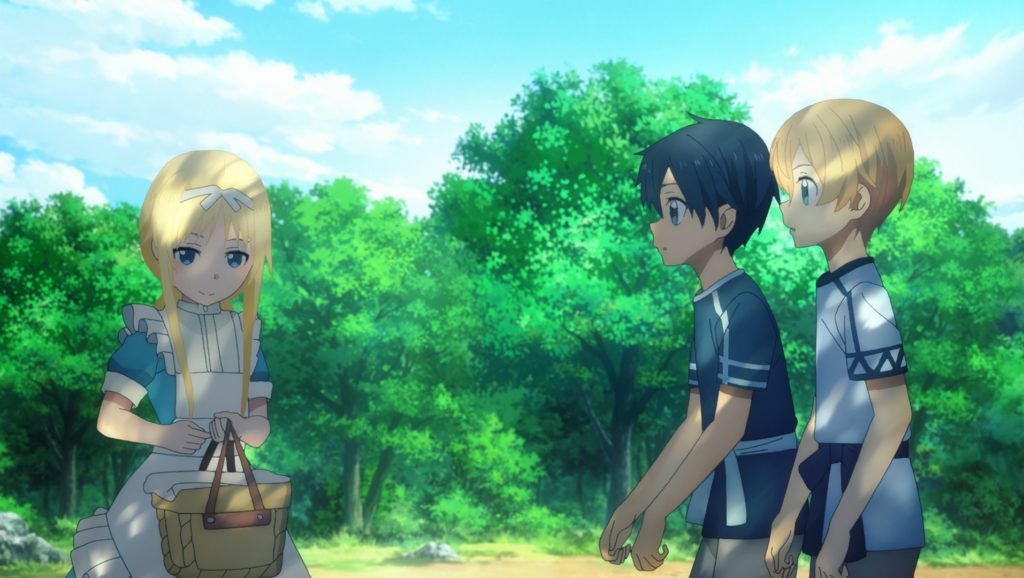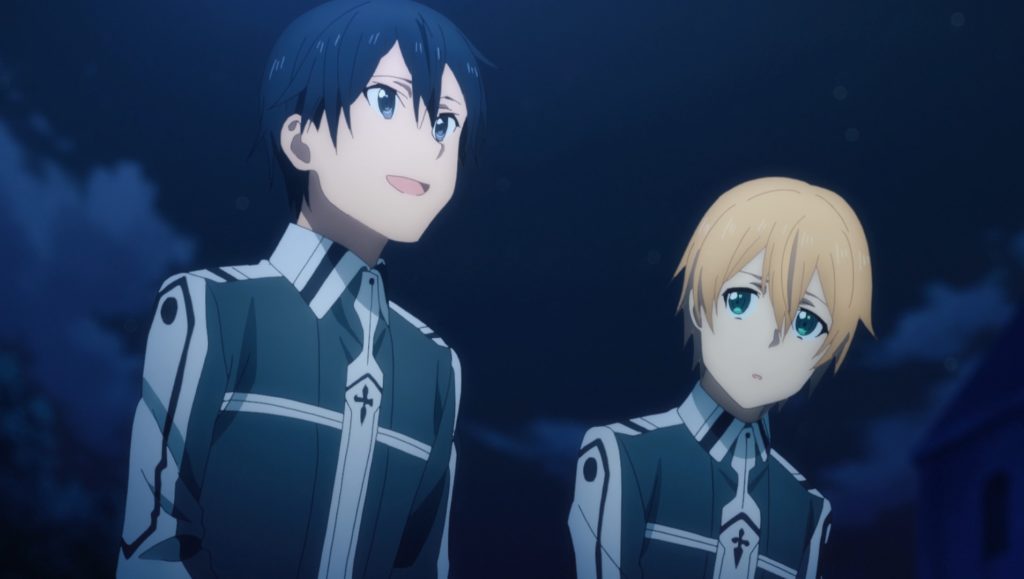Sword Art Online: Alicization Part 1 Review
WARNING: Contains spoilers to previous collections, and this series is only suitable for over-18s. Includes violent scenes, including some of a sexual nature.
One of the things that first strikes you when you come across the latest collection of SAO is the rating: 18. Previous releases have been given 15 ratings but not 18. What appears in this series that would have forced to the censors to rule that the series should only been seen by adults? A look at the cover shows that the BBFC have ruled that the series: “Contains sexual violence, strong violence.”
“What sexual violence”, you ask? Well, if you are at all familiar with Sword Art Online, whether it be the anime, manga or the original light novels by Reki Kawahara, you will know that when it comes to villains, they tend to be one-dimensional, and that dimension is, “rapist”, with no explanation or character development to detail what might make such a person, real or digital, do such a terrible thing. It’s just: “Baddie is a rapist, Kirito stops them.” This may be enough for people not to buy the series at all, but if it isn’t, then let’s examine what the series is actually about.
It begins with what appears to be a rather younger-than-normal Kirito in another fantasy-like virtual realm. However, he appears to be behaving as if this world is not virtual. It is like the world is real and that he has been here all of his life. This realm is called “Underworld”, and his best friend is a boy called Eugeo, a woodcutter whose family have been tasked to cut down one gigantic tree – a task that has taken the family several generations to achieve. Kirito helps him in his work, while a girl from their village called Alice, looking very much like her namesake in Alice in Wonderland, gives them meals.

The three decide that if they can get some ice, they can preserve Alice’s food better. Thus they make the decision to go to an ice cave in a mountain range to get some. The cave was once home to a dragon, long since slain, and while there, they come across a magic but heavy sword called the Blue Rose Sword. The trio get lost on the way back and end up appearing on the border between Underworld and the Dark Territory, an area that they cannot enter under the strict laws of the “Taboo Index”, written by the Axiom Church that rules the Underworld. The trio see two knights fighting on the back of dragons, with one knight falling down near them. Alice goes to help, trips up, and lands with her fingers just touching the Dark Territory, thus breaking the law. The following day, having returned home, an “Integrity Knight” representing the church comes to arrest her, taking her away to Underworld’s capital, where she will be executed. Both Kirito and Eugeo are powerless to stop the knight. After this, Kirito wakes up in the real world, crying.
We soon learn that Kirito is taking part in another technological experiment. A company called Rath is developing “Full-Dive technology”, which allows a person to enter a virtual world and act in it as if it is the real world. It works by using a “Soul Translator”, a machine that allows people to dive by reading a type of quantum particle called “fluctlight”, which contains the human consciousness, i.e. a person’s soul. Among the problems with it however (apart from the obvious fact that this appears to have no scientific basis, but this is sci-fi so I think we can make allowances) is that when diving in, you have no memory of the real world, and when you come out, you have no memory of what happened in the virtual one. Another issue with it is that in the virtual world, time moves at a different pace. A few hours in Underworld would feel like a few days, while a few days can feel like a month.
As Kirito and Asuna are on their way home one night, Kirito expresses a desire to travel to California to look at the latest dive technology there, with Asuna supporting him. However, as they walk back, they encounter a familiar face, a man named Johnny Black, who is the last survivor of the Death Gun incident in the Gun Gale arc, who attacks Kirito. Kirito stabs Johnny with an umbrella, but Johnny is able to stab Kirito with a syringe full of poison.
When Kirito wakes up, he finds himself in Underworld, but this time he still has some of his memories from the outside world. In a short while, he encounters a more grown-up Eugeo and becomes friendly with him once more, but neither of them have memories of the other. Kirito also discovers that he still has his online sword fighting skills and is able to put them to good use. Eugeo reveals to Kirito details about the Underworld, what happened to Alice all those “years” ago, and that Eugeo was able to drag the Blue Rose Sword from the ice cave and keep it hidden away. Together, Eugeo and Kirito are able to sharpen their sword fighting skills, allowing them to finally slice down Eugeo’s tree. As a result, Eugeo is allowed to change his job or “Calling”. He decides to become a swordsman, and together the two travel to Underworld’s capital, not just to train as swordsmen, but also to try and see if Alice is in fact still alive.
As for what happened to Kirito in the real world, the poison caused his heart to stop beating for five whole minutes. He is still alive, but now in a coma which he may never come out of, and he might even have brain damage. Asuna later learns that he has been taken to a secret medical facility. With some help from her old friends, their virtual child Yui, and some of Kirito’s old email contacts, Asuna traces Kirito to what is the only place that can not just keep Kirito alive, but even heal him: an offshore research facility using the Soul Translator. There Asuna meets Kirito’s government handler Kikuoka, who tells Asuna that they are not only using the Soul Translator to restore Kirito’s brain, but also to help develop an artificial intelligence in Underworld. This is part of “Project Alicization” – a plan to develop an AI to be used in warfare. Kikuoka hopes this will mean that it will reduce human casualties in war. Asuna is against it, supporting the rights of AI.

This collection of episodes has its positives and negatives. On the plus side, the series deals with some new topics. We look at the role of artificial intelligence and whether such a thing would be capable of having the same rights as people. It also deals with the subject of time, with Kirito experiencing the world at an accelerated pace relative to us. For him, years pass as he travels Underworld and eventually joins an academy mastering sword fighting with Eugeo. The idea of being in a virtual world that feels as realistic as our world is also a curious one. Plus, for once in the story it is Asuna who is trying to rescue Kirito from his predicament rather than the other way around. The quality of the production of the series is also high: great animation and great music (by Yuki Kajiura) work together to make the series enjoyable… on the whole.
However, there are issues. For starters, there is a lot of very peculiar science tossed around in this collection. I admit to not knowing much about quantum physics, but can the human soul really exist in the form of light-emitting particles within the human body, and could such a thing be used to repair the brain?
The biggest issue however, and not for the first time in SAO, is the use of rape in the series. Of all the times rape has used in SAO, this is the most graphic and the hardest to watch in the series so far. I had to look away when viewing it because I found it so disturbing. The scene follows a period in which Kirito and Eugeo have been in the sword fighting academy for a while, and now have their own pages, the girls Ronie and Tiese respectively. At the same school are two more students, Humbert and Raios, snobbish members of the aristocracy who consider themselves to be the law. After Eugeo spars with Humbert in a match that is declared a draw, Humbert starts forcing his own page to do some disturbing but never fully explained acts. Ronie and Tiese express their concern. Later, Ronie and Tiese go missing, and when Eugeo goes to confront Humbert and Eugeo, he finds the two girls bound and gagged on a bed. What happens next is truly disturbing and contains scenes of bloody violence and acts that will be triggering.

These rape scenes in SAO are the most annoying thing about the entire series. This is partly because of the fact that we see the cliché of damsels in distress having to be rescued by our dashing hero Kirito, while the female leads are away from the action (Asuna, and indeed all of Kirito’s friends, have not entered Underworld at any point). The other problem is that Kawahara almost always seems to give minimal back-story on the villains. He never seems to explain what makes someone become a rapist, he just uses it as the default setting of making anyone the baddie. Was the villain abused themselves early on in their life? Was it because of the way they were brought up? Was it a fault in the programming of the world, perhaps caused by a computer virus? Who cares! It’s just someone for Kirito to attack so he can save the day. It is lazy writing, made clearer by the fact that Kawahara can make more interesting villains when he can. The creator of the original “Sword Art Online” game, Akihiko Kayaba, shows this. He was a murderer with an interesting back story, and indeed is referred to in Alicization.
These rape scenes are a shame because the settings that Kawahara makes, as well as some of the ethical issues regarding technology are worth talking about, but this stuff just gets in the way of the whole thing. No wonder so many people openly dislike SAO. Personally, the stories are interesting and fantastical enough for me to enjoy, but I know that the series also has some serious things that need improving.
As for the collection itself, there are a fair amount of extras. If you go with the Blu-ray collection you get a slip case, six art cards, and on the discs there are both Japanese and English dubs, Japanese language promos, web premiers, and textless opening and closing. The artists on these tracks will be familiar to SAO fans, as they have performed on the series previously. Personally speaking, I prefer the opening theme, “Adamas” by LiSA, over the ending “Iris” by Eir Aoi, but both are good in their own right.

This first part does contain some of the most horrific moments in SAO, but I hope that the second collection will be an improvement. It is setting up for an interesting battle with Kirito and Eugeo having to take on the “Administrator” of this virtual world.


